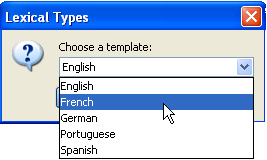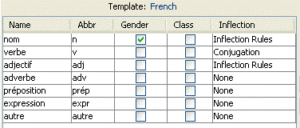This tutorial will walk you through creating a lexicon specifically targeted to the language you’re learning. If you’re learning Spanish, French, Portuguese, German, or English then you’ll use a built in language template. Otherwise, you’ll find out how to define your own lexical types. After your lexicon is created, you’ll see how to enter in your first lexical item and theme.
Note that if you want a quick tour of the program’s features then you may want to check out the video overview.
Creating a Lexicon
| Step 1: | Go to the File menu and select New Lexicon. This produces the New Lexicon dialog. |
| Step 2: (recommended) |
Enter a new lexicon name. It’s recommended that you name your lexicon using the language that you’re learning. |
| Step 3: (recommended) |
Enter a new name for language 1. This is the language that you’ll be using for lexical item definitions. Typically, this is your native language, but it might also be the name of the language you’re learning if you’re an advanced student in that language. |
| Step 4: (recommended) |
Enter the name of the language you’re learning into the Language 2 field. |
| Step 5: | Notice the contents of the Lexical Types tab. The template name is in blue and is set to the current user interface language, probably English. If you’re learning Spanish, French, Portuguese, or German then you’ll use a language template, so click the Language Templates button in the lower right corner. If you’re not learning one of these languages then you’ll need to define your own list of lexical types. In this case, jump to Step 1a of Defining Your Own Lexical Types. |
| Step 6: | In the Language Templates dialog, select the language you’re learning from the dropdown then click Ok. |
| Step 7: | Once the template is changed, you’ll see a list of lexical types for the language you selected. It’s important that you understand what each name means. Later, as you enter lexical items into your lexicon, you’ll assign a lexical type to each one. You can revert the names to their English equivalents to make this assignment easier, but it isn’t recommended because lexical types are the building blocks of a language and it’s a good idea to know them well in your target language. This way you can ask questions of your teacher without reverting to English. |
| Step 8: (optional) |
If you want to add lexical types of your own then jump to Step 2a of Defining a Lexical Type. |
| Step 9: | Click Ok. You’ve created your first lexicon! Now you are ready to enter lexical items and themes. |
Defining Your Own Lexical Types
| Step 1a: | If you are creating all new lexical types because you can’t use one of the language templates then you first need to remove all the default lexical types. To do this, simply select the first lexical type in the list. Then, click the Remove button until all types have been deleted. Notice that the template name will change to Custom. |
| Step 2a: | Click the Add button underneath the list of lexical types. This action will bring up the New Lexical Type dialog. |
| Step 3a: | At the top of the dialog, enter a name for the lexical type and an abbreviation. It’s recommended that you enter the name in the target language, not your native language. The abbreviation should be no longer than 4 characters in length. |
| Step 4a: (optional) |
If lexical items of this type are to be assigned a gender then add each possible gender by clicking the Add button underneath the list of genders. Each one needs to have a name and an abbreviation. Also, click the Assignment Required checkbox if the program should insist that new lexical items of this type have a gender assignment when you enter them. Click the checkbox Some items change gender if some lexical items are allowed to change gender. See Defining a lexical item in the manual for for details. |
| Step 5a: (optional) |
If lexical items of this type are to be assigned a lexical class then add each possible class by clicking the Add button underneath the list of classes. As with genders, each lexical class needs to have a name and an abbreviation. Also, click the Assignment Required checkbox if the program should insist that new lexical items of this type have a class assignment when you enter them. See Defining a lexical item in the manual for for details. |
| Step 6a: (optional) |
If you want to enter conjugations for lexical items of this type then you need to define them on the Inflection tab. On this tab, select Conjugation from the dropdown. Add each conjugation descriptor (usually a verb tense, sometimes combined with a mood) by clicking the Add button underneath the table on the left. Give the descriptor a name and check the Singleton checkbox if it is a solitary conjugation. Add conjugation forms (usually pronouns) by clicking the Add button underneath the table on the right. Finally, click the checkbox Show form identifiers with each conjugation. See Defining conjugations for a lexical type in the manual for more details. |
| Step 7a: (optional) |
If you want inflected forms of lexical items to be recognized automatically then you will need to add Inflection Rules on the Inflection tab. This option is for advanced users, so it’s recommended that you don’t add them now. Instead, you can return to this lexical type definition and add them later. If you insist on adding them now then see Defining inflection rules for a lexical type in the manual. |
| Step 8a: | Click Ok. This will return you to the New Lexicon dialog where you will see the lexical type you just added in the list. Repeat steps 2a through 8a for each lexical type you want to define. |